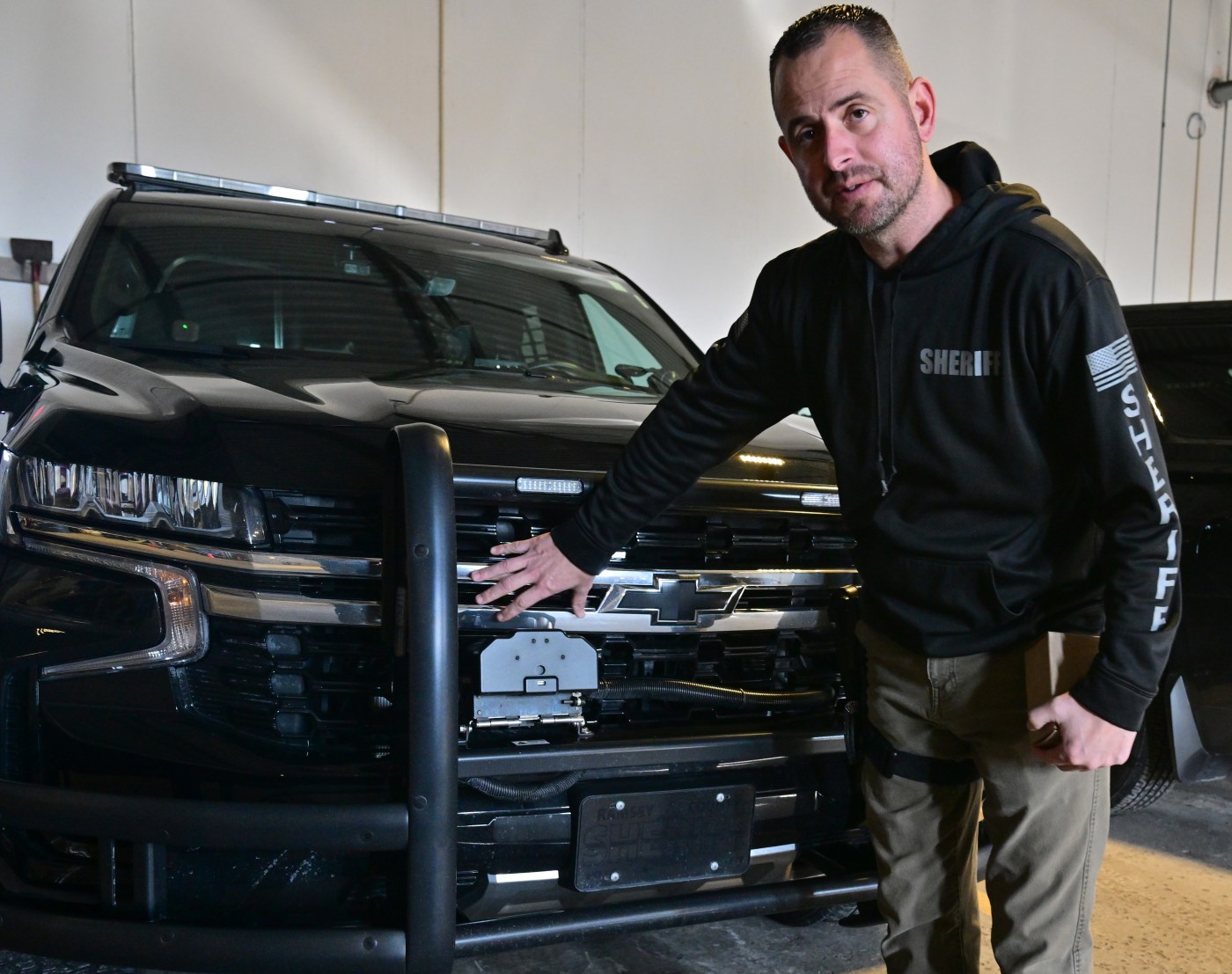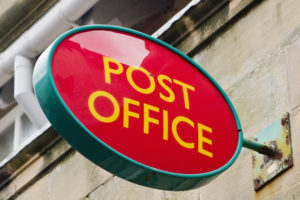
Sticky, magnetic GPS trackers are helping local police catch fleeing suspects without high-speed chases
When Ramsey County Sheriff’s Deputy Joe Kill heard that two boys had stolen a Toyota RAV-4 left running in a Little Canada woman’s driveway, he was ready.
Kill, who was on patrol in the area, got behind the stolen vehicle near Interstate 35E and Larpenteur Avenue and deployed a GPS tracking device that stuck to the car’s license plate.
The GPS tracker, touted as a safer alternative to police pursuits, meant that Kill could back off and let Ramsey County Sheriff’s Office investigators track the unit from their computers at patrol headquarters, he said. They, in turn, radioed the location of the car to deputies, and the suspects were apprehended about 10 miles north of Little Canada, Kill said.
The GPS tracker and pneumatic launcher, made by a Virginia Beach, Va., company called StarChase, is “another tool in our tool box to deploy when needed, when the timing is correct,” Kill said.
The Ramsey County Sheriff’s Office started using StarChase in spring 2022 and has spent $36,000 for the product and tech support, said Steve Linders, a spokesman for the department. The department received a grant from the Minnesota Department of Commerce’s Auto Theft Prevention Program to fund the technology, he said.
Here’s how it works: A launcher powered by compressed air is mounted either on the push bumper of a squad car or behind the grille of an unmarked squad car. The launcher is loaded with two cylindrical tracking devices – each about the size of a small soda can.
A GPS tracking dart from the StarChase vehicle-mounted GPS launcher system. (John Autey / Pioneer Press)
Using a control panel inside a squad car, an officer fires the GPS tracker at a car, using a laser to assist. Once the tracker makes contact and attaches to the suspect’s vehicle, it begins relaying GPS coordinates and vehicle speed via a web-based app, providing real-time information about the vehicle’s location. The officer in the squad car can then fall back and wait for an investigator to coordinate a safe arrest.
The devices are “part-magnet, part-adhesive,” Kill said. “Once you activate the system, it’s like a little mini-oven, and it heats up the element and the stick. It won’t allow you to fire it until it gets to temp, and that helps the adhesive stick if it’s wet or there’s a little bit of dirt or snow.”
After the suspects have been apprehended, “you can walk up, grab it and peel it right off like a sticker,” Kill said.
Safer, but limited by law
Woodbury police started using StarChase technology in August as part of an initiative to reduce the need for high-speed chases, said Sgt. Chris Donahoe, operations sergeant with the Woodbury Police Department. The initiative coincided with a post-COVID increase in auto thefts, he said.
“It was across the board – a higher number of vehicle thefts combined with an increase in vehicles fleeing from officers,” he said.
The department budgeted $60,000 for the system, which is currently installed in seven squad cars. Police have had two StarChase deployments: One was on a stationary vehicle that didn’t flee, and another was on a car that was stolen. “When the GPS unit made contact with the (stolen) car, the offender pulled over and surrendered,” Donahoe said.
If the department deploys a tracking dart, the company will immediately replace it, he said.
Another plus: The technology can be shared across jurisdictions, Donahoe said. “Being able to share that information is a big plus,” he said.
“High-speed pursuits are probably one of the most dangerous things that police officers engage in,” Donahoe said. “They put not only suspects at risk, but also the police officer at risk and, most importantly, the community at risk. Any technology that can allow us to still be effective, but do it in a safer manner, we’re in favor of.”
Under Minnesota law, the technology can be used to track only stolen cars, and the GPS tracking can happen for only 24 hours after the tracking device attaches to a stolen vehicle unless law enforcement obtains a search warrant to extend the time window. Police agencies also must remove the GPS tracker once they recover the stolen vehicle, according to state law.
Police in Woodbury would like to see the law amended so StarChase technology “can be used on all vehicles that flee,” Donahoe said. “Many states across the country are already doing this.”
“Let’s say a person robs a bank at gunpoint and flees in a vehicle,” he said. “Officers locate the vehicle and attempt a high-risk traffic stop, and the vehicle then flees. Under the current law, we would not be able to deploy StarChase in this scenario.”
Related Articles
St. Paul community turns out to support family that lost four children in house fire
Candles have started more than 300 fires in the past five years in Minnesota
Picture emerges of tragic St. Paul fire that killed four children
Prosecutors urge rejection of Chauvin’s bid to dismiss civil rights conviction in Floyd murder
White Bear Township man sentenced in woman’s fentanyl overdose death
The city of Maplewood obtained a grant in 2021 from the state’s Auto Theft Prevention Program that helped fund the installation of StarChase equipment in four squad cars in the city, said Lt. Joe Steiner of the Maplewood Police Department.
Because StarChase technology must be deployed within 20 feet of the suspect’s vehicle, Steiner said it has been difficult to successfully use the technology.
“There are a lot of criminals involved in auto theft, and they are somewhat fluent in evading police,” Steiner said. “Drivers of stolen vehicles often flee without us getting an opportunity to get within distance to deploy (the device). We feel strongly that property crime doesn’t outweigh the risk to public safety when pursuing vehicles. If they are going the speed limit, sure, we can drive behind them and deploy it, but once they see the police, they are gone. They immediately start driving at a high rate of speed.”
The GPS trackers also can be deployed via a remote fob if the officer is not in a squad car at the time of deployment. They also can be deployed using a handheld launcher.
De-escalate and apprehend
The StarChase vehicle-mounted GPS launcher system on a Ramsey County Sheriff’s Office squad car. (John Autey / Pioneer Press)
The average suspect apprehension rate using StarChase technology is 86 percent, compared with a 72 percent apprehension rate of “traditional, high-speed pursuits” that were reported nationwide through the National Highway Traffic Safety Administration, said Trevor Fischbach, founder of StarChase. “Those traditional chases also come with the carnage and loss of life,” he said.
On average, suspects tracked by StarChase slow to within 10 mph of the posted speed limit within two minutes of being tagged, he said.
The company, which has contracts with agencies in 37 states, Canada, the United Kingdom, Israel and Australia, has helped recover more than $300 million in assets since it was founded in 2010, Fischbach said. The company began selling its products commercially in 2014.
StarChase “was designed as a pursuit-mitigation product and has proven itself as a de-escalatory suspect-apprehension tool,” Fischbach said.
“It was designed to de-escalate high-speed vehicle events while not bringing additional risk into an already difficult situation,” he said. “We are very proud of the fact that we don’t alter the dynamics of the suspect’s vehicle in any way, shape or form. It doesn’t bring more risk to an already risky situation.”
Agencies pay about $1,200 to $1,500 a year for the StarChase program, which includes unlimited rounds, mapping access and data storage, Fischbach said.
The GPS technology is designed for short-term immediate suspect tracking and is not intended as a long-term surveillance tool, alleviating potential privacy concerns, Fischbach said.
The American Civil Liberties Union has reviewed and supports the use of the technology, he said.
The product has been designed to affix in “virtually all environmental considerations, including sub-freezing temperatures,” he said.
During a recent demonstration in Harrisburg, Pa., the temperature was 7 degrees Fahrenheit, and the GPS tags “were pretty much welded to the back of the vehicle,” Fischbach said.
While the adhesive is “very aggressive,” it does not damage the vehicle, he said.
During a recent deployment in Colorado, police tracked an armed suspect via StarChase technology for almost 200 miles. “It started in Denver, and it went across three counties and multiple towns,” he said. “It resulted in a safe felony arrest without injury or fatalities.”
‘Not a panacea’
Linders, of the Ramsey County Sheriff’s Office, said the circumstances have to be right for StarChase to work.
“It’s not a panacea,” he said. “It’s not going to end every pursuit. It’s not going to stop every car theft or allow us to recover every stolen car. It’s not the right tool for every incident.”
Kill, the Ramsey County deputy, said the stars were aligned when it came to using a StarChase tracker to recover the red Toyota RAV-4 that had been stolen in Little Canada.
A control panel for the StarChase GPS launcher system in a Ramsey County Sheriff’s Office squad car. (John Autey / Pioneer Press)
The juveniles continued north on I-35E to County Road J, where they exited the interstate, he said. When they tried to turn into the parking lot of Emagine White Bear movie theater in White Bear Township, they got stuck in a ditch.
“We boxed them in right there in the ditch, and we arrested both the juvenile males,” Kill said.
A deputy drove the owner of the car to the site. Once the tracker was removed from her license plate, she was able to drive home, he said.
“She was happy,” he said.
Related Articles
Candles have started more than 300 fires in the past five years in Minnesota
Driver dies after truck plunges through ice on Mille Lacs Lake
St. Paul police release 911 transcript, body cam video of shooting after assault call
Two years after Dru Sjodin killer’s sentence overturned, review of medical examiner’s work continues
Dru Sjodin’s story, ‘Missing from the Mall,’ to be featured on ’20/20′


